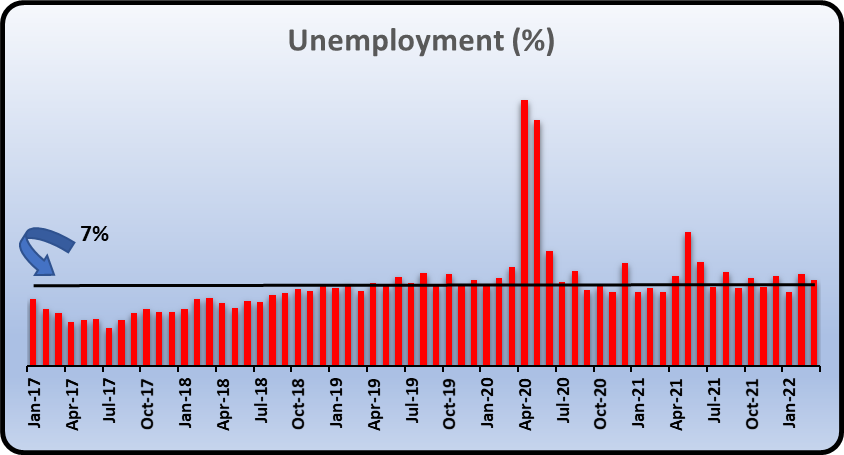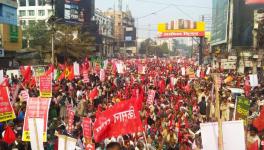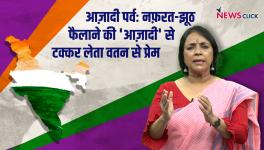Amrit Kaal: Crushed Under Joblessness and Low Wages
In the past five years, the economic slowdown, pandemic and its disastrous response and the Narendra Modi government’s indifference to the common people has led to a steadily worsening economic crisis. The government, perhaps buoyed by electoral successes, has given up on reviving the living condition of the people.
Jobs are not even mentioned nowadays in sarkari discourse although the unemployment rate has stabilised at an unconscionable 7% or more since about October 2018, as shown in the chart below derived from data collected by sample surveys done by Centre for Monitoring Indian Economy or CMIE.

All the talk of bounce-back of the economy or V-shaped recovery is meaningless since people are not getting adequate jobs. Meanwhile, the share of the working age population, which is either working or seeking jobs has – astonishingly – declined from about 45% in January 2017 to about 40% in March 2022. [See chart below]

What does this mean? This means that more and more people are simply getting frustrated and discouraged by the lack of jobs and sitting idle – they opt out of the job ‘market’ as it is described. A large share of them are young people who start doing some courses or other studies, in the hope of preparing themselves better for the illusory jobs of the future.
The total number of employed persons in India has shrunk in these five years from 40.1 crore in January 2017 to 39.6 crore although India’s population has increased in the same period from 130.5 crore to 137.4 crore based on population projections by the Census office.
Incomes and Jobs
A recent analysis of CMIE data has shed some light on two important aspects: incomes and unemployment across different strata of people.
-
Poorest (annual income less than Rs.1 lakh): This section made up 9.8% of all households in 2019-20, that is, before the pandemic. By 2021-22 their share had increased to 16.6%. Unemployment rate in this section is low – it was 4.1% in Sept-Dec 2019-20 and 4.8% in the same months of 2021-22. But work participation rate in this stratum was abysmal at 38.1% before the pandemic and just 31.3% in 2021-22. Median income of households in this section was a mere Rs.53,000 per year. So, they are barely surviving. Clearly, the unemployment rate in itself is meaningless.
-
Lower middle class (annual income between Rs.1 – 2 lakh): They make up about 45% of all households. They account for about one-third of all unemployed persons. It rose slightly during the pandemic but by end 2021 had returned to previous share. The work participation rate is better than the poorest section but worse than richer sections.
-
Middle class (annual income between Rs.2 – 5 lakh): These households account for about half of all households and also contain half of all unemployed persons. This is the section that is the biggest sufferer of joblessness. Work participation rate is high at 43% but so is unemployment rate at 9%.
-
The richer sections -- upper middle class (annual income between Rs.5-10 lakh) and the rich (annual income above Rs.10 lakh) have much better work participation rates of about 46% and lower unemployment rates of about 5%. During the pandemic their unemployment rate went through the roof but they have nicely bounced back now. It is these sections that have seen the fabled V-shaped recovery.
Sombre Glimpse of Lower Depths
All this data is from sample surveys and may suffer from usual errors, including definitional ones. The classification is admittedly “not by percentiles as is the norm in academic work but by tangibly rounded values of annual household incomes”.
But it does provide a rather sombre glimpse of India’s struggle with incomes and jobs.
The most striking thing is the pitiable household income levels. About 57% of households, according to this survey, earn less than Rs.2 lakh per year. That works out to about Rs.16,666 per month. Of course many earn much less than that – about 17% earn less than Rs.8,333 per month.
As mentioned, the median annual wage is just Rs.1.7 lakh or about Rs.14,000 per month. The survey has not revealed the hours of work that gets this wage – other surveys and anecdotal evidence suggests that usually people work for more than eight hours to earn this much.
This also shows the prevalence of what is called ‘hidden unemployment’. This is when people are forced to work for very low wages because there is no other option – either they starve or work for whatever is available. This phenomenon is not limited to the poorest sections only. Even in the so called middle class, large sections are working for very low salaries, hoping for the much-hyped achhe din promised by Modi.
Get the latest reports & analysis with people's perspective on Protests, movements & deep analytical videos, discussions of the current affairs in your Telegram app. Subscribe to NewsClick's Telegram channel & get Real-Time updates on stories, as they get published on our website.
























